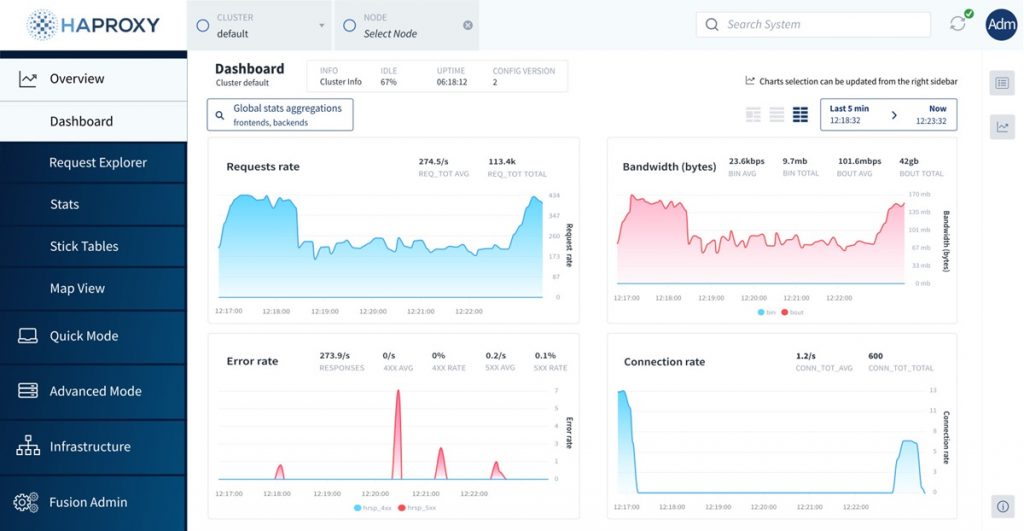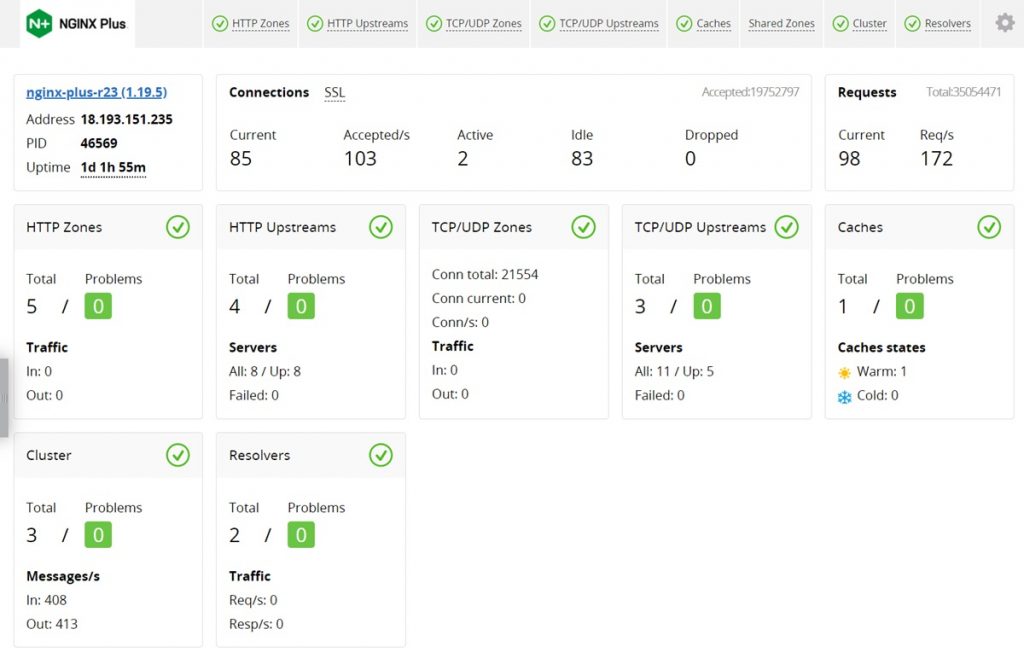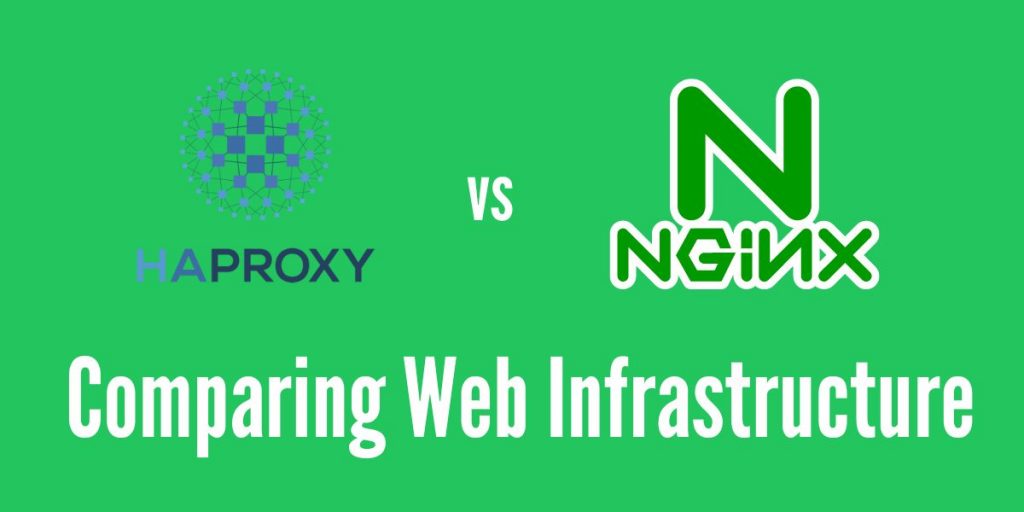Optimizing your web infrastructure can often lead to small but vital differences in performance. This can be especially true for sites that see larger traffic volumes. To this end, we compare HAProxy vs NGINX, two applications capable of load balancing.
Table of Contents
- What Are HAPRoxy and NGINX?
- Key Features Compared
- HAProxy vs NGINX Performance
- Configuration and Usability
- Scalability and High Load Handling
- Security Features
- Deployment Cost and Other Considerations
- Final Thoughts and References
1. What Are HAPRoxy and NGINX?
| HAProxy | NGINX | |
| Introduced | 2000 | 2004 |
| Creator | Willy Tarreau | Igor Sysoev |
| Primary Focus | Load Balancing and High Availability. | Web Server, Reverse Proxy, and Load Balancer. |
| Architecture | Event-driven architecture | Event-driven, asynchronous architecture |
| Initial Objective | Efficiently managing high traffic loads and ensuring reliability | Solving the C10k problem |
| Evolution | Enhancements driven by community feedback | Expanded beyond a web server to include reverse proxying and more |
| Key Strengths | High availability, detailed health checks, and SSL termination | Efficient static content delivery, handling of concurrent connections, versatility |
| Commercial Version | HAProxy Enterprise | NGINX Plus |
HAProxy, standing for High Availability Proxy, is a specialized load-balancing software. It was introduced in 2000 by Willy Tarreau to improve the availability and scalability of web applications.
NGINX, comparatively, emerged slightly later in 2004. The brainchild of Igor Sysoev, NGINX was initially created to solve the C10k problem — the challenge of handling 10,000 concurrent connections on a single server.
The critical difference between these two applications is that NGINX has changed significantly. Today, NGINX can fill multiple roles, including serving as a web server, reverse proxy, and email proxy (for IMAP/POP3).
2. Key Features Compared
| HAProxy | NGINX | |
| High Availability | Automatic traffic redirection for failed servers | Load balancing and server health checks |
| IPv6 Support | Yes | Yes |
| Load Balancing Algorithms | Round Robin, least connections, source IP-hash, weighted Round Robin, and weighted least connections | Round Robin, least connections, IP-hash, hash, consistent hash, weighted Round Robin, weighted least connections, and random (two combined) |
| Health Checks | Active and Passive | Active and Passive |
| SSL Termination | Yes | Yes |
| Session Persistence | Yes | Yes |
| Reverse Proxy Capabilities | Yes | Native support, excelling in directing client requests |
| Caching | Yes, but complex | Built-in caching |
| Rate Limiting | Yes | Yes |
HAProxy works by distributing network or application traffic across multiple servers. This helps achieve its aims of more efficient and reliable handling of high website traffic loads. It’s designed to ensure high availability and reliability across web services.
On the other hand, NGINX is more well-known since it serves many users as a web server. It can manage multiple connections on a single thread. This helps reduce the need for extensive hardware resources and enhances request processing performance.
a. IPv6 Support
One notable feature that’s often overlooked is IPv6 support. It’s essential to consider this due to the exhaustion of IPv4 address space. Thankfully, both HAProxy and NGINX currently fully support IPv6 addresses. However, note that they provide slightly different benefits.
For example, NGINX can operate in a dual-stack environment, simultaneously handling IPv4 and IPv6 connections. That ensures compatibility and reachability across different network types. This is less relevant in HAProxy, which only needs to ensure IPv6 compatibility.
Are you facing IP addressing issues?
Consider renting them in bulk. RapidSeedbox offers IPv4 and IPv6 rentals, ensuring you can access a ready pool whenever necessary. Use them for every need, from co-location networks to in-office deployment.
—————
3. Performance: Is HAProxy or NGINX Better?
| HAProxy | NGINX | |
| Dynamic Content Handling | N/A | Capable |
| Static Content Delivery | N/A | Excellent |
| Concurrent Connections | 60,000 Simultaneous | 512 to 1,024 Requests per worker |
| Max Requests Per Second | Up to 2 million (theoretical) | 400,000 to 500,000 (theoretical) |
| Caching | Yes, but complex. | Built-in caching |
| Rate Limiting | Yes | Yes |
HAProxy and NGINX are designed to handle high traffic volumes efficiently. However, their performance strengths lie in slightly different areas. HAProxy is particularly strong at managing dynamic content and complex load-balancing scenarios.
Comparatively, NGINX shines in serving static content and managing many concurrent connections. These capabilities are primarily due to its event-driven architecture and caching mechanisms.
a. Which is The Better Option?
The choice between HAProxy and NGINX for performance optimization should, therefore, be based on the specific needs of your application.
For scenarios requiring advanced load balancing and high availability, HAProxy may offer superior performance.
Conversely, NGINX could provide the edge in performance and efficiency for applications with a heavy emphasis on handling numerous concurrent connections.
4. Configuration and Usability
| HAProxy | NGINX | |
| Configuration | File-based (single configuration file) | File-based (Modular configuration) |
| Syntax Complexity | Can be complex for beginners. | Generally simpler and more readable. |
| Learning Curve | Steeper due to detailed and complex configuration options. | Easier. Extensive documentation and a vibrant community |
| GUI for Configuration | Yes (HAProxy Enterprise) | Yes (NGINX Plus) |
| Flexibility and Control | Advanced options for load balancing, health checks, and traffic routing | High, though HAProxy may offer more granular control |
| Community Support | Good | Excellent |
HAProxy and NGINX have slight differences in their approach to configuration and management. Understanding the differences may influence your choice, depending on your team’s expertise and specific requirements.
a. HAProxy Configuration

HAProxy allows precise control over load-balancing behavior and traffic management. Its configurations are file-based (typically defined in a single file), which can be both a strength and a challenge.
The strength of HAProxy’s configuration lies in its ability to handle intricate load-balancing scenarios. This makes it an excellent choice when granular control over traffic distribution and server health monitoring is required.
b. NGINX Configuration

One of the critical reasons that NGINX is celebrated is its simplicity and efficiency. Configuration is relatively simple, even for those with minimal web server management experience.
Like HAProxy, NGINX utilizes a file-based configuration system. The NGINX system is often praised for its clear and readable syntax. The commercial version (NGINX Plus) also provides a GUI for configuration and monitoring.
More importantly, configuration files are designed to be modular. This leads to surprising benefits, such as the ability to include specific files for different domains or applications. It’s an impressive capability that can simplify management for complex setups.
5. Scalability and High Availability
| HAProxy | NGINX | |
| Scalability | Excellent | Excellent |
| High Availability | Excellent | Excellent |
| Load Balancing | Excellent | Excellent |
| Session Persistence | Good | Good |
| Health Checks | Excellent | Good (Better in NGINX Plus) |
| Content Handling | Layer 4 and 7 load balancing | Layer 4 and 7 load balancing |
Both HAProxy and NGINX offer strong capabilities in scalability and high availability, but their approaches and strengths vary slightly:
- HAProxy is particularly adept at complex load balancing scenarios. It can provide fine-grained control over traffic distribution. It also ensures high availability through detailed health checks and session persistence mechanisms.
- NGINX is particularly efficient at the handling of static content. It can manage many concurrent connections, making it ideal for scaling web applications. Its reverse proxy and caching features also reduce backend server load, enhancing scalability.
HAProxy is capable of scaling dynamically with the demands of web traffic. It can efficiently distribute traffic across multiple servers, adjusting as demand increases or decreases. Coupled with its load-balancing algorithms, HAProxy can scale services without sacrificing performance.
It is especially well-known for its high availability features. Features in this regard include built-in health checks, auto traffic re-rerouting, and support for sticky sessions.
NGINX can easily handle tens of thousands of connections on modest hardware. This makes it incredibly efficient at scaling up to meet the needs of high-traffic websites and applications. Built-in load balancing features and content caching further this capability.
Like HAProxy, NGINX includes several server health checks and failover mechanisms. These features help it maintain the availability of web services. Additionally, NGINX Plus offers a live activity monitoring dashboard.
6. Security Features
| HAProxy | NGINX | |
| SSL/TLS Termination | Yes | Yes |
| Access Control Lists (ACLs) | Detailed ACLs | Basic, via IP-based restrictions and password protection. |
| DDoS Mitigation | Yes, via rate limiting and connection limits | Comprehensive rate limiting to protect against DDoS and brute-force attacks |
| HTTP Request Sanitization | Can inspect and modify HTTP requests to prevent web vulnerabilities | No |
| Buffer Overflow Protection | No | Yes |
HAProxy and NGINX have features and tools that safeguard against web threats. They are also continually updated to address new security challenges. Rather than features, a more vital concern is the capability to configure them as effective safeguards.
If your primary concern is detailed access control and request filtering, HAProxy might be the more suitable option. Conversely, if you need strong rate limiting and protection against overflow attacks, NGINX could better serve your requirements.
Both tools boast strong communities and extensive documentation, which can help reduce operational costs by providing resources for troubleshooting and optimization.
7. Deployment Cost and Other Considerations
When deploying a web infrastructure solution like HAProxy or NGINX, understanding the total cost of ownership and other crucial considerations is essential.
These factors can significantly influence the choice between HAProxy and NGINX, affecting short-term and long-term strategic decisions.
a. HAProxy Cost and Other Factors
- License Cost: HAProxy is open-source and free to use. There are no direct license costs associated with its deployment.
- Operational Costs: Operational costs, including server resources, maintenance, and the potential need for specialized personnel, can add up.
- Support Costs: HAProxy offers a commercial version for businesses requiring guaranteed support, HAProxy Enterprise. This brings support and additional features.
b. NGINX Cost and Other Factors
- License Cost: NGINX offers both an open-source version, which is free, and a commercial version, NGINX Plus.
- Operational Costs: The straightforward configuration and extensive documentation of NGINX can lower operational costs.
- Support Costs: Subscription fees for NGINX Plus include support services. This can be a crucial consideration for enterprises requiring immediate web infrastructure assistance.
Are you facing IP addressing issues?
Consider renting them in bulk. RapidSeedbox offers IPv4 and IPv6 rentals, ensuring you can access a ready pool whenever necessary. Use them for every need, from co-location networks to in-office deployment.
—————
8. Final Thoughts
Ultimately, the decision to choose HAProxy or NGINX should be guided by technical requirements and the existing infrastructure. To decide which to deploy, the most essential areas will be task and purpose.
Regardless of the choice, both HAProxy and NGINX are robust. They are more than capable of enhancing your web applications’ performance, reliability, and security. Choosing the right tool will address current needs and scale your operations.
References
- Ma, Chen, and Yuhong Chi. “Evaluation test and improvement of load balancing algorithms of nginx.” Ieee Access 10 (2022): 14311-14324.
- Qin, E., et al. “Research on nginx dynamic load balancing Algorithm.” 2020 12th International Conference on Measuring Technology and Mechatronics Automation (ICMTMA). IEEE, 2020.
- Dymora, P., M. Mazurek, and B. Sudek. “Comparative Analysis of Selected Open-Source Solutions for Traffic Balancing in Server Infrastructures Providing WWW Service. Energies 2021, 14, 7719.” (2021).
- Rawls, Connor, and Mohsen Amini Salehi. “Load balancer tuning: Comparative analysis of haproxy load balancing methods.” arXiv preprint arXiv:2212.14198 (2022).

0Comments